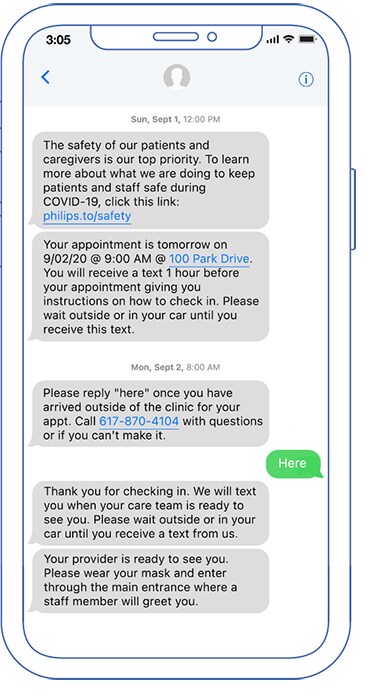Radiology
What if every patient showed up on time and prepared for their imaging test?
An ideal day is one in which every patient shows up on time and ready to be imaged. After all, your substantial investment in imaging equipment and a well-trained staff goes unused if suddenly there is no patient there to scan.
What if you could help more patients show up on time and well prepared so that imaging exams are a positive experience for all? Healthcare organizations are using integrated digital communications right now to increase engagement and reduce no-shows.

At a glance
Challenge
Patients who don’t show up for their imaging appointments – or who show up late or unprepared – interrupt imaging operations, limit valuable access for others and put their own health outcomes at risk.
Results
Integrated digital communications for patient management and personalized tools that help create a less stressful experience for imaging patients are helping organizations meet operational and patient care goals.
Share this article
How serious an issue are patient no-shows?
Patients who are late, ill-prepared or don’t show up at all affect the experience of your staff, your service continuity, and their own health and wellbeing. When technologists can’t get the image right the first time, it’s often because the patient hasn’t been properly prepared – or because of missing or inadequate patient information.1 Delays in diagnosis and treatment can have serious, long-term effects on not only the patient’s health, but also the ability of a service already under stress to meet workload demand.
No-shows account for up to

7%
of patients for some imaging modalities2

$ 1M
Potential loss in lost revenue $1,000,0003
Productive engagement eases concerns, reduces patient no-shows
Two great examples of patient engagement are interactive digital communications and personalized coaching tools. Cloud-based, integrated digital communications can help patients better prepare for imaging exams while reducing patient no-shows. Practical steps guide a patient at defining moments in the journey, helping imaging departments improve productivity and patient satisfaction. Personalized coaching tools to prepare pediatric patients for MR exams can help inform, educate, engage and comfort patients throughout the care journey.
Enhance patient engagement with interactive digital communications: patients have a virtual waiting room with contactless check-in via text message.

Step 1: Pre-appointment preparation
Educate patients on access protocols.
Step 2: Patient arrival
Patients text “here” and will receive a notification informing them to stay outside the building until it’s time to be seen.
Step 3: Clinic notification
The EHR is automatically updated with the patient’s arrival status.
Step 4: Ready to be seen
Staff input a status change into the EHR indicating that the patient is ready to be seen.
Step 5: Guide the patient
Notification is delivered to the patient alerting them that they may enter the clinic.
Help make MR exams less stressful for pediatric patients through personalized coaching tools.

How leaders are driving patient engagement
Boston Medical Center (BMC), Yale New Haven Health and Lahey Hospital & Medical Center are finding that engaging with patients digitally helps ease patient anxiety and encourages them to keep their radiology appointments.
Providing timely and updated information has been critical in our efforts to keep both our staff and patients safe during this pandemic."
Kathleen Masters
Sr. Manager, Ambulatory Performance Boston Medical Center Boston, MA
BMC deployed patient management from Philips across 33 ambulatory departments as part of a health system initiative to improve its operational and patient experience metrics.
Results from BMC
⇣ 19%
reduction in no-shows4
4.4/5
patient satisfaction score, as measured by patient satisfaction surveys4
⇣ 14%
reduction in late cancellations4
Go deeper
Are you interested in learning more about how to address your challenges?
Case study
Advancing key performance indicators with pre-visit navigation.
Brochure
Responding to COVID-19 with an end-to-end digital workflow.
Share this article
At a glance
Challenge Patients who don’t show up for their imaging appointments – or who show up late or unprepared – interrupt imaging operations, limit valuable access for others and put their own health outcomes
Results Integrated digital communications for patient management and personalized tools that help create a less stressful experience for imaging patients are helping organizations meet operational and patient care goals.
Would you like to know more about ways to help patients show up on time and well prepared?
Take a deeper look at the solutions that are helping radiology departments inform, educate, engage and comfort patients throughout the care journey.
*Results presented are for illustrative purposes only and are not predictive of actual results for your business. 1. Radiology Staff in Focus: A Radiology Services Impact and Satisfaction Survey of Technologists and Imaging Directors. Research Report. 2019. Philips 2. Rosenbaum JI, et al. Understanding why patients no-show: observations of 2.9 million outpatient imaging visits over 16 years. J Am Coll Radiol. 2018;15(7):944-950. www.doi.org/10.1016/j.jacr.2018.03.053 3. Mieloszyk RJ, et al. The financial burden of missed appointments: uncaptured revenue due to outpatient no-shows in radiology. Current Problems in Diagnostic Radiology. 2018;47(5): 285-286. www.doi.org/10.1067/j.cpradiol.2018.06.001 4. Advancing key performance indicators with pre-visit navigation: a case study with Boston Medical Center. 2020. Philips.
